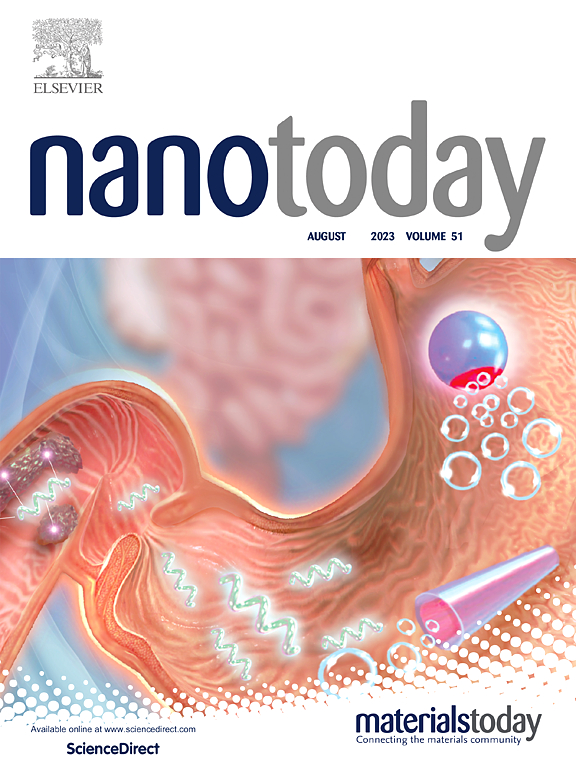原位氧化反应纳米疫苗协调光敏剂和STING激动剂用于癌症光免疫治疗
IF 13.2
1区 材料科学
Q1 CHEMISTRY, MULTIDISCIPLINARY
引用次数: 0
摘要
癌症疫苗已成为一种有前途的癌症治疗范例。然而,肿瘤相关抗原的缺乏和大量的免疫抑制因子严重降低了免疫治疗的疗效,导致临床获益不佳。在本报告中,我们设计了一个协调的免疫刺激纳米平台,称为MP@PPS NPs,通过物理结合活性氧(ROS)响应的聚(硫化丙)纳米颗粒,负载光敏剂焦磷素a (PPa)和干扰素基因刺激剂(STING)激动剂(MSA-2),作为原位癌症疫苗来放大免疫治疗效果。MP@PPS NPs具有良好的稳定性,延长了药物循环时间,促进了肿瘤的蓄积,同时其体积小,促进了药物在肿瘤内更深的渗透。至关重要的是,在激光照射下,MP@PPS NPs可以产生丰富的ROS,诱导肿瘤消融,触发免疫原性细胞死亡,启动适应性抗肿瘤免疫应答,促进MSA-2的局部释放,从而通过cGAS-STING途径促进先天抗肿瘤免疫。MP@PPS NPs显著抑制原发性和远处肿瘤进展,促进树突状细胞成熟,增加细胞毒性T淋巴细胞浸润,引发强大的抗肿瘤免疫。同时,MP@PPS NPs治疗联合抗pd - l1治疗可阻止肺转移。这项工作对协同光动力免疫治疗具有重要的前景,并为解决抗肿瘤免疫不足和癌症治疗无效的问题提供了重要的启示。本文章由计算机程序翻译,如有差异,请以英文原文为准。
In situ oxidation-responsive nanovaccine coordinates photosensitizer and STING agonist for cancer photo-immunotherapy
Cancer vaccine has emerged as a promising therapeutic paradigm for cancer therapy. However, the lack of tumor-associated antigens and abundant immunosuppressive factors seriously diminish the efficacy of immunotherapy, resulting in poor clinical benefits. In this report, we engineered a coordinated immunostimulatory nanoplatform, termed MP@PPS NPs, by physically combining reactive oxygen species (ROS)-responsive poly (propylene sulfide) nanoparticles loaded with the photosensitizer pyropheophorbide a (PPa) and stimulator of interferon genes (STING) agonist (MSA-2), to function as an in situ cancer vaccine to amplify immunotherapeutic outcomes. Excellent stability of MP@PPS NPs endowed prolonged drug circulation time and improved tumor accumulation, while their small size boosted deeper drug penetration within tumors. Crucially, upon laser irradiation, the MP@PPS NPs could generate abundant ROS, which induced tumor ablation, triggered immunogenic cell death to initiate an adaptive antitumor immune response and facilitated the local release of MSA-2, thereby promoting innate antitumor immunity through the cGAS-STING pathway. MP@PPS NPs markedly suppressed both primary and distant tumor progression, promoted dendritic cell maturation and increased cytotoxic T lymphocyte infiltration, elicited robust antitumor immunity. Meanwhile, MP@PPS NPs treatment impeded the lung metastatic in conjunction with anti-PD-L1 treatment. This work holds significant promise for the synergistic photodynamic immunotherapy, and offers a crucial inspiration for addressing the problems of insufficient antitumor immunity and ineffective cancer treatments.
求助全文
通过发布文献求助,成功后即可免费获取论文全文。
去求助
来源期刊

Nano Today
工程技术-材料科学:综合
CiteScore
21.50
自引率
3.40%
发文量
305
审稿时长
40 days
期刊介绍:
Nano Today is a journal dedicated to publishing influential and innovative work in the field of nanoscience and technology. It covers a wide range of subject areas including biomaterials, materials chemistry, materials science, chemistry, bioengineering, biochemistry, genetics and molecular biology, engineering, and nanotechnology. The journal considers articles that inform readers about the latest research, breakthroughs, and topical issues in these fields. It provides comprehensive coverage through a mixture of peer-reviewed articles, research news, and information on key developments. Nano Today is abstracted and indexed in Science Citation Index, Ei Compendex, Embase, Scopus, and INSPEC.
 求助内容:
求助内容: 应助结果提醒方式:
应助结果提醒方式:


